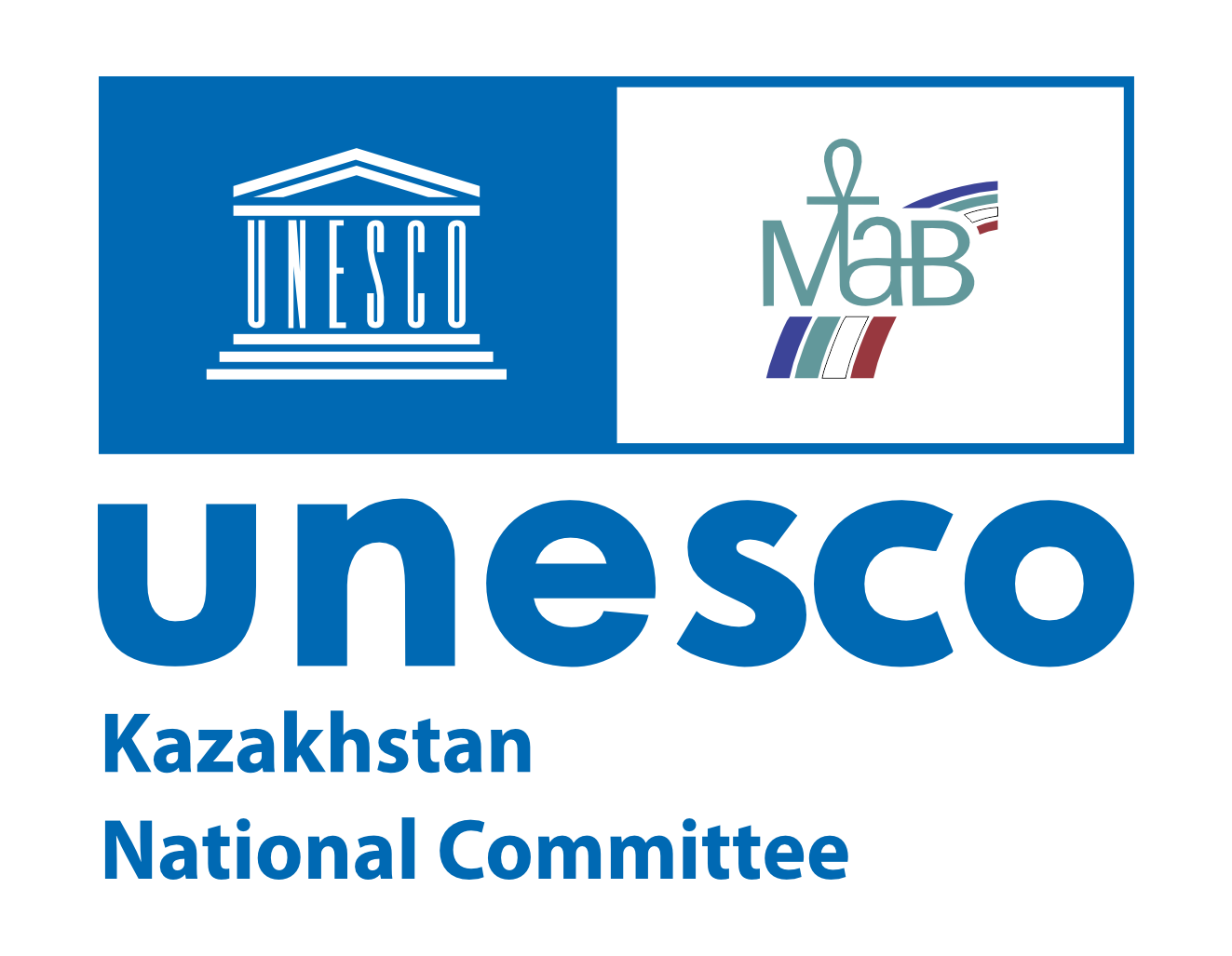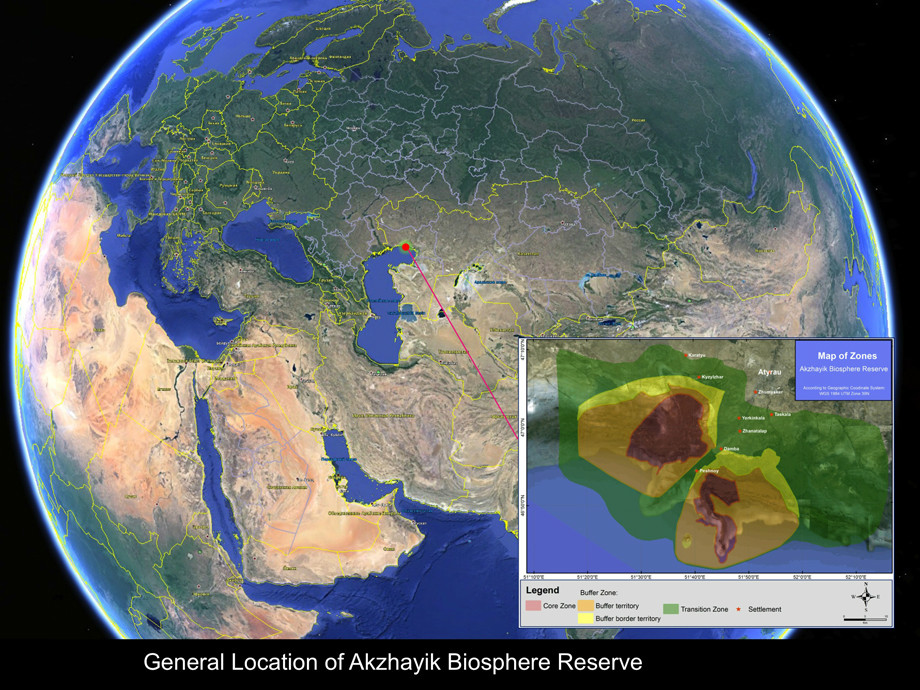
Total terrestrial area of the territory of Akzhaiyk Biosphere Reserve is about 340 846 ha. The main core is 36 077 ha, buffer zone is 104 769 ha (according to legislative acts: buffer territory 75 423 ha and buffer border protected territory 29 346 ha of the State Nature Reserve), development zone – about 200 000 ha. The marine area is about 55 500 ha and consists of about 500 ha core zone, 25 000 ha buffer zone and 30 000 ha transition zone.
In accordance with Article 50 of Chapter 1 of the Law of RK “On specially protected natural territories”: “the state natural reserve shall be a particularly protected wildlife area registered as nature conservation and scientific organization containing land and water ecological systems, intended for protection restoration and maintenance of biological variety of natural complexes and natural and historical objects relating thereto”.
The primary activity of the state wildlife reserves shall include the following: 1) conservation and restoration of biological and landscape variety of ecological systems; 2) ensuring of the protection regime of the state wildlife reserve; 3) maintenance of stable development of the territory on the basis of the eco-economic principle of natural resources utilization; 4) arrangement of research and monitoring operations for the purposes of protection and stable development of the territory, and ecological education as well; 5) regulation of the use of the state wildlife reserve’s territory and its protective area for the eco-educational, scientific, recreational, tourist, and limited economic activity purposes.
The main zone of biosphere reserve is strictly protectedzone of nature reserve regime of Akzhayik state nature reserve, which represents natural wetland complex of Ural river delta and coastal lands of the Caspian Sea with adjacent water territories. Legal basis for Akzhayik nature reserve creation is Resolution of the Government of RK № 119 as of 6 February 2009. Total area of both parts of the core zone of Akzhayik state nature reserve is 36,077 ha.
In accordance with Article 50 Chapter 3 paragraph 1: “core zone — the core zone intended for the long-term conservation of genetic resources, biological variety, ecological systems and landscapes with sufficient sizes for such purposes”. In accordance with Article 51: “1. Within the reservation conditions zone of the state wildlife reserve scientific researches and monitoring of the environment shall be performed, including keeping the Nature Chronicles, along with eco-educational arrangements. 2. Within the reservation conditions zone of the state wildlife reserve any economic and recreational activities shall be prohibited under the reservation conditions established, which shall be corresponding to the protection regime of the state wilderness area.”
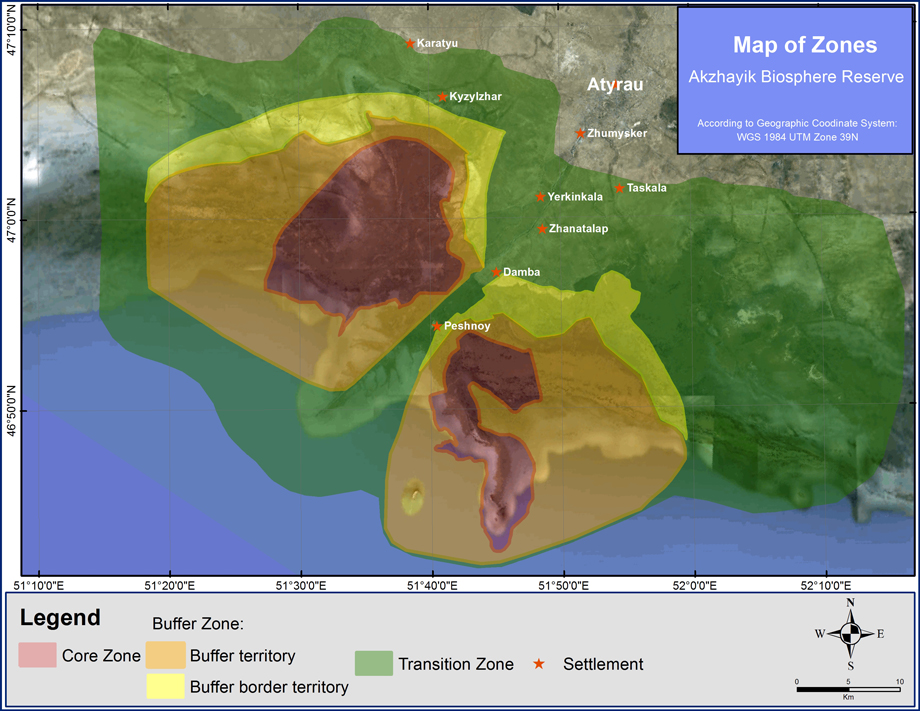
On specially assigned areas, which do not include especially valuable ecological systems and object, it is permitted, in the order stipulated by the authority, to create excursion paths and routes for conducting regulated ecological tourism. Akzhayik state nature reserve corresponds to the highest category (A1) of IUCN natural territories.
The core zone consists of two parts, divided by Ural river. Left side of this zone has an elongated shape, lies in administrative limits of Atyrau lands. Its Northern border goes along dry land from Ural river bank (Southern from Peshnoy observation station) to the East to the crossing with the border of Kurmangazy production cooperative's lands; then it goes South-Eastern along the border of Kurmangazy production cooperative to marine coast; then along the marine waters to the South, bypassing Peshnoy peninsula, and North-Western to the bank of Ural river; then it goes in North-Eastern direction for about three to five km from the main river bed along the left bank (to Peshnoy observation station). Total area of left-side part of the core zone is 8,056 ha. Right-side part of the core zone is located in administrative borders of Makhambet district of Atyrau oblast, its total area is 28,021 ha.
Buffer zone of Akzhayik biosphere reserve comprises the lands of the buffer and protected territories of state reserve. Legal basis for the use of this territory as a buffer is Resolution of the Government of RK № 119 as of 6 February 2009 and Decree of the Akim of Atyrau oblast № 108 as of 7 April 2011 on the designation of protective 2-km zone along the border of nature reserve. The Decree of Akim indicated that designation of the protective zone is carried out without withdrawal of land from the land users. According to Article 50 of Chapter 2 of the Law of RK «On SPNA»: «buffer zone — the area used for ecologically oriented economic activity and stable reproduction of biological resources». This zone is created to protect specially protected natural territories from unfavourable influences from the outside, with prohibition of any activity that may negatively influence the condition and restoration of the given territory's ecosystems.
According to Article 52 within the buffer zone of the state wildlife reserve the following forms of regulated and limited economic activities may be implemented: “1) scientific research and organization of training centers; 2) monitoring of environmental conditions and changes in ecological systems; 3) forestry, fire arrangements and protection of woodlands; 4) traditional land use within the limits of ensuring long-term integrity and invulnerability of biological variety of the core zone and stability of ecological systems of the state natural reserve on the whole; 5) enlarged arrangements for restoration of biological and landscape variety and natural ecological systems; 6) tourism and recreation regulated according to recreational load, specified by the rules for visiting Protected areas by physical persons; 7) utilization of mineral waters and treatment resources; 8) ecological education, implementation of training programs, organization of demonstration sites and management of environmentally sound use of natural resources”.
At the same time within the buffer zone the following is prohibited: “1) establishment of new settlements; 2) location and operation of industrial objects; 3) construction and operation of production facilities; 4) exploration and mining operations; 5) final felling operations; 6) introduction of new species of plants and animals; 7) actions changing the hydrological conditions of the core and buffer zones; 8) other activities capable to affect the ecological system of the core zone”.
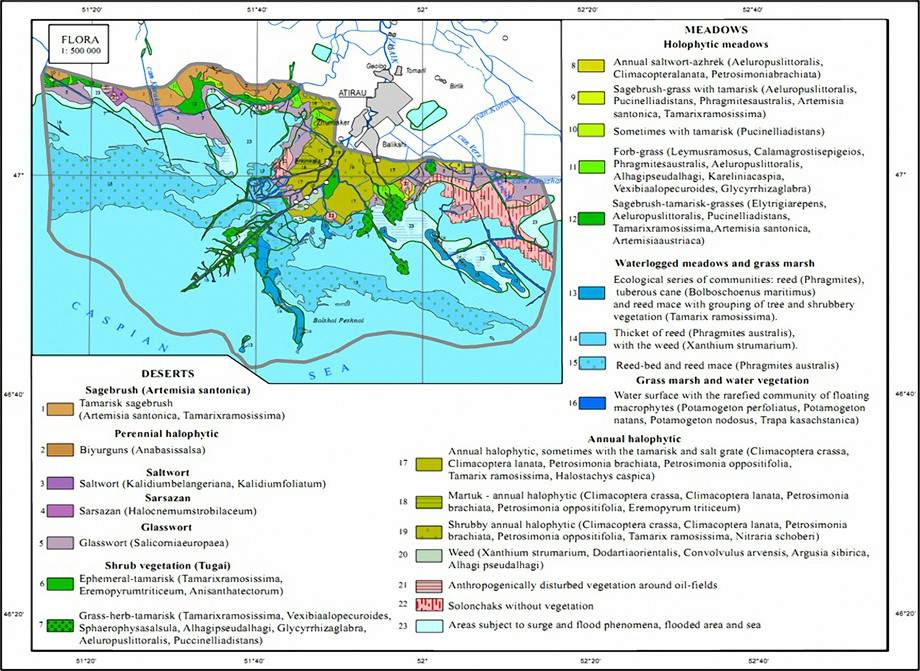
Within the buffer zone of biosphere reserve economic activity in some parts of the protection zone (haymaking, cattle pasture) is carried out by agreement with state authority (Forestry and Hunting Committee of the Ministry of Agriculture of RK) and under the control of the administration of state nature reserve. Eco-educational, tourist, and recreational activities are conducted on the territory of biosphere reserve’s buffer zone, as well as scientific research.
The area of the buffer zone is 104,769 ha, 43,658 ha of it is on the right bank in Makhambet district of Atyrau oblast and 61,111 ha on the left bank in Atyrau city lands.
Transition zone (collaboration zone) of Akzhayik biosphere reserve is located on the territory of Atyrau and Makhambet district of Atyrau oblast. This zone comprises lands of 6 rural districts: Atyrau district, Atyrau, Damba, Yerkinkala, Kenozek and Chkalovsk, its total approximate area is 200,000 ha. In this zone there are 9 production cooperatives, 7 of them are fisheries and 2 cooperatives of multi-directional production, emplying only 30% of total number of working age population, as well as many small private enterprises. Besides, there are two active sturgeon farms (Atyrau and Damba farms), hiring about 150 local people. In Chkalovo village there is Pervomayskiy Ltd. – the main and largest agricultural company of Atyrau oblast, processing milk and growing meat and dairy cattle.
The territory of biosphere reserve's transition zone is used for hayfields, fallow lands, pastures, numerous wetlands and villages. It represents mostly areas which were developed and settled a long time ago. It is necessary to organize restoration of renewable natural resources on those territories. First of all, it considers the rehabilitation of fallow lands and organization of sustainable fishing and hunting. One of perspective directions of this zone is the development of ecological tourism.
All three zones are connected and complement each other. The core zone is closed for visits and represents reference areas of regional natural complexes, as well as important genetic reserve of wild flora and fauna species; this zone is a control in long-term monitoring. The buffer zone is also under protective regime, but limited human activity is allowed here (such as tourism, scientific research, educational programs, partial use of natural renewable resources, etc.). Both zones serve for conservation of natural complexes and partially for sustainable development. The transition zone is used for living of local people, development of economy, culture and education. Here there is no strict protection regime of natural complexes, but there are some restrictions on the nature use (ecologically dirty production is prohibited). As a whole, this zoning provides conditions for elimination of the conflict between social-economic development and protection of wild natural complexes and gives an opportunity for stable development of economy and culture.
For organization of partner relations a special Coordinational Council of Akzhayik biosphere reserve was created; its participants include representatives of state nature reserve, nature users, local authorities and public organizations
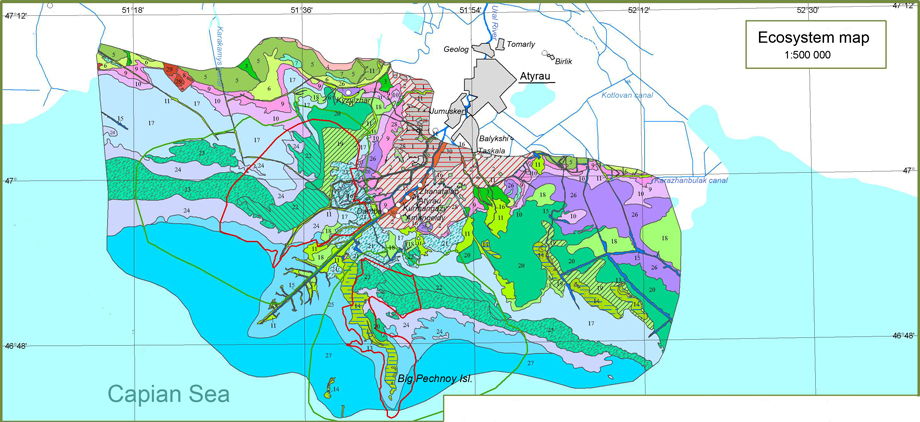
Local communities are involved in the development of biosphere reserve's Management Plan and by participating in the Coordinational Council in the integrated reserve's management. Complete management of the core and buffer zone is conducted by the administration of Akzhayik state nature reserve, but local NGOs, local communities receive full information on natural complexes of the zones that will be used for education, as well as for tourist routes in the buffer and transition zones, development of scientifically based sustainable nature use, etc.
During the UNDP/GEF Wetlands Project in 2004 – 2011 one of the expert groups carried out thorough research of social-economic situation in this region. In the limits of this work the influence of the environment and economical situation on cultural and social life of local people was assessed. In the future this data was used during nature resere organization for effective territory zoningand nature protection measures’ planning.
According to Kazakhstan's legislation, management of economic activity on some parts of biosphere reserve's buffer zone (haymaking, cattle pasture) is carried out by agreement with state authority (Forestry and Hunting Committee under the Ministry of Agriculture of RK) and under control of state nature reserve's administration, all questions and arising problems are settled at the meetings of Coordinational Council of biosphere reserve. All activities on the lands of the protected zone were negotiated with all land users in the course of preparation of the Resolution of Akim of Atyrau oblast № 56 as of 2 March 2011 and № 108 as of 7 April 2011 on establishment of 2-km protection zone on the border of Akzhayik State Nature Reserve. Private lands of the buffer zone were not withdrawn from the land users.
At the present time there is a Management Plan for core and buffer zones of Akzhaiyk Biosphere Reserve, which describes management of the main protected areas of Biosphere Reserve. In the transition zone the land users have their own management plans, which are in accordance with Management Plan of core and buffer zones. So, simple combination of all these plans is in fact Overall Integrated Management Plan of the whole territory of Biosphere Reserve. All controversial issues are discussed at the sessions of Coordinational Council of Biosphere Reserve.
The biosphere reserve is managed through Akzhayik Biosphere Reserve Coordinational Council created in 2012. Before that the territory of the core and buffer zone was and is managed by the administration of Akzhayik State Nature Reserve, and collaboration zone is managed by Akimats of Makhambet district and Atyrau city. In the present time Coordinational Council is a collegial public body created to introduce policies of effective management and sustainable use of biosphere reserve's resources, alternative activities, resource-conserving and resource-restoring technologies. The Coordinational Council of biosphere reserve consists of representatives of state agencies (territorial agency of forestry and hunting, oblast territorial agency of fishery), state nature reserve, Akimats (department of land resources, agriculture, etc.), local NGOs and land users, and is necessary in providing collaboration and problem-solving opportunities for all stakeholders.
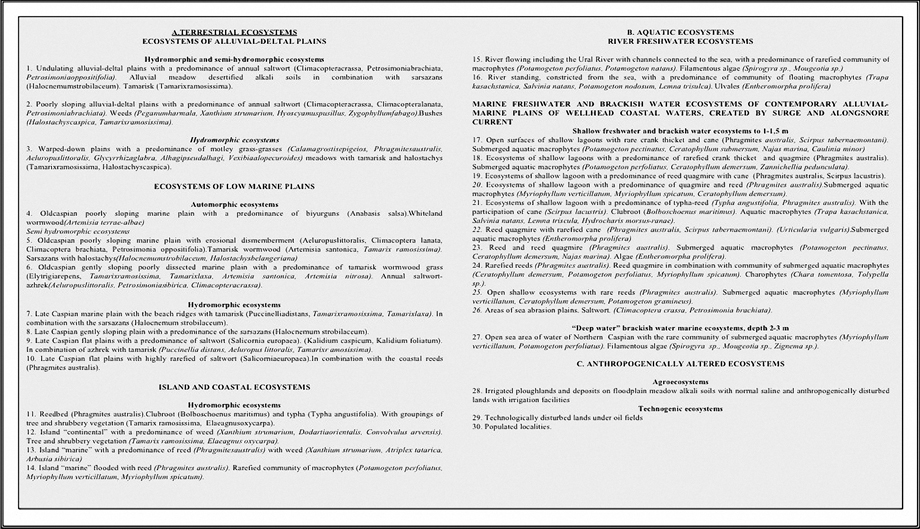
There is a current monitoring of the condition and conservation of natural complexes on the territory of biosphere reserve, and monitoring of rare and threatened species to clarify the condition of the populations, ecological peculiarities of rare plant and animal species, providing a basis for evaluation of the species’ conservation and restoration perspectives. The goal of the monitoring is to obtain regular objective data about the condition of plants and animals on the territory of biosphere reserve, as well as on the condition of their habitat. Based on monitoring data it is necessary to conduct current evaluation of the condition of populations and ecosystems, biosphere reserve’s functioning effectiveness, and development of measures for critical and unfavourable situations’ prevention. Air counting of large waterbirds (swans, flamingo, pelicans, etc.) and Wild Boar are carried out in the limits of monitoring program.
According to the perspective thematic plan of scientific research, the work on the territory of biosphere reserve is carried out for 6 scientific themes: 1) Observations of natural phenomena and processes on the territory of the Reserve and their study for the «Nature Chronicles» program, 2) Akzhayik Nature Reserve's flora and vegetation inventorizaiton, 3) Rare and endangered birds of Akzhayik Nature Reserve and adjacent territories, 4) Teriofauna of Akzhayik Reserve (species composition, biology, residence status), 5) Characteristics of ichthyofauna of Akzhayik Reserve, 6) Monitoring of phyto-zooplankton of Ural river delta.
The department of ecological education of nature reserve is responsible for organization and conduction of cultural-educational activities; it consists of 6 people: department's chief, 2 specialists in ecological education, translator, excursion manager and museum chief. Cultural-educational work is also done by the staff the department of science, information and monitoring. The goal of this department's work is forming ecological literacy, understanding of the key role of the protected territory, importance of unique nature's conservation, public support gaining, as well as raising patriotism and responsibility for the environment and, as the result, decrease of anthropogenic press on region's biodiversity.
With the support from UNDP/GEF Wetlands Project 10 staff members of state nature reserve had a chance to raise their qualifications and exchange experience in Astrakhan biosphere reserve (Russia), 2 people went to Korgalzhyn biosphere reserve (Kazakhstan). In 2009-2011 different educational seminars were held for Reserve's staff concerning a variety of topics: management plant development, biodiversity monitoring, inspectors' training in report compilation procedure, compliance with the safety rules and fire-fighting techniques.
An important role in staff preparation is played by international Kazakhstan-Italian Ural River Park Project, supported by ENI Company; Italian side of the Project is represented by a research group of Bologna University under the guidance of Prof. Gabbionelli, and Kazakhstan side is represented by Akzhayik Reserve’s staff. This Project gives an opportunity to share experience in nature parks’ management between Italian biosphere reserve Po River Delta Park and Akzhayik Reserve, also Italian specialists help in researching nature of Ural delta, organizing ecological tourism, GIS technologies introduction and awareness campaigns (exhibitions, contests, festivals, Bird Days, etc.).
Biosphere Reserve occupies mainly wetlands of Ural river delta and adjacent territories of Caspian Sea coast, which are located on one of the largest in Eurasia Caspian – Black Sea – Eastern African migration route. This territory is included in the Ramsar Convention's List of wetlands of international importance and is a concentration site for more than 240 migrating bird species, about 110 of which are waterbirds, including 18 specially protected species. Besides, this biosphere reserve is a nesting site for about 70 waterbirds, 8 of which are specially protected natural objects. It is also a haven for a rare bird’s colonies – Dalmatian Pelican (Pelicanus crispus, VU) – with population reaching more than 600 nesting pairs (12% of the global population). There are 292 bird species recorded for Ural river delta and adjacent sea coast in total, 26 of them are listed in the Red Data Book of Kazakhstan and IUCN Redlist. According to expert evaluations, total number of birds during migration goes up to 3 million specimens.
In the present time Ural river delta and adjacent aquatic and terrestrial ecosystems are the last untouched areas of wild nature in the rgion and serve as a refuge for many species of wild fauna and flora, especially for sturgeon fishes which are recently threatened to complete extinction. Out of 6 sturgeon species inhabiting Caspian basin 4 come to Ural river for spawning: those are Beluga (Huso huso), Starry Sturgeon (Acipenser stellatus), Russian Sturgeon (Acipenser gueldenstaedtii) and Bastard Sturgeon (Acipenser nudiventris), and two other species – Sterlet (Acipenser ruthenus) and Persian Sturgeon (Acipenser persicus) – are sometimes observed in this river's delta. In total, aquatic ecosystems of biosphere reserve are inhabited by 76 out of 126 species and subspecies of fish and cyclostomes, registered for Caspian Sea and belonging to 17 families. The dominating position is occupied by carp fish – 42 species and subspecies, followed by gobies – 32-35 and herrings – 18 species and subspecies. All other families, including sturgeons, are represented by not more than 1-7 species. The delta itself is supporting 47 species, 5 of which are listed in the Red Data Book of Kazakhstan. Amphibians are represented by 2 species, and reptiles – by 20 species, of which 2 species of snakes are listed in the Red Data Book of Kazakhstan – Four-lined Snake Elaphe quatuorlineata and Caspian Whipsnake Hierophis caspius.
There are 48 mammal species of 7 orders, recorded on the territory of biosphere reserve, with rodents and predators being most representative. Aquatic parts of biosphere reserve are nowadays the only protected territories for conservation of endemic relict species (at the same time the only representative of mammal fauna in Caspian Sea)- Caspian Seal (Pusa caspi c a) – which is listed in the Redlist (IUCN, Endangered). Besides this species, another Red Data Book species is found here – Bobrinski's Serotine. It is possible that sometimes a very rare and specially protected species – Desman – may come to the delta from the middle stream of Ural and nest on the territory of biosphere reserve. In quantitative concern dominating species include mammal species, such as Muskrat, House Mouse, Tamarisk Gerbil, raccoon, fox, wolves, badgers and wild boar.
Fauna of terrestrial and aquatic invertebrates consists of about 2,000 species, including 24 species listed in the Red Data Book of Kazakhstan. Macrozoobenthos of Ural rivr delta with adjacent coast of the Caspian Sea is represented by 67 species and forms of 6 groups, among which there are: Hydrozoa – 1, sponges – 1, worms – 11, crustaceans – 30, molluscs – 5, insect larvae – 19. Zooplankton of the lower stream of Ural river contains 315 species and subspecies, including 30 protozoans, 154rotifers, 71 cladocera and 54 copepods; the rest are plankton’s optional inhabitants. Insect fauna of the biosphere reserve is represented by 820 species of 61 families and 15 orders. The basis of insect fauna is made of dragonflies species (order Lestidae , Coenagrionidae , Aeschnidae , Libellulidae), praying mantis (Mantidae ), homopterans (Cicadellidae , Aphidinea), heteropterans (Corixidae , Nepidae , Miridae , Lygaeidae), orthopterans (Acrididae , Gryllidae, Tettigoniidae), beetles (Dytiscidae , Carabidae , Staphylinidae, Coccinelidae , Scarabaeidae, Elateridae , Tenebrionidae , Chrysomelidae , Curculionidae), butterflies (Geometridae , Noctuidae, Pyralidae, Pieridae , Lycaenidae), hymenopterans (Ichneumonidae, Braconidae, Sphecidae, Eumenidae, Formicidae), dipterans (Culicidae , Chironomidae , Asilidae , Bombyllidae , Muscidae , Syrphidae , Ephydridae).
The nominated territory of biosphere reserve contains 229 species of higher plants of 141 genera, 56 families, among them 7 species are relict and 4 species are rare and specially protected. Aquatic flora is represented by 23 plant species. The main vegetation associations are represented by 6 types: desert, meadow, marsh, forest, shrubs, water-submerged. Vegetation associations are dominated by halophyte perennial saltworts (semi-dwarf shrubs, dwarf shrubs, shrubs) – Halocnemum strobilaceum, Kalidium caspicum, K . foliatum, Anabasis salsa, Halostachys caspica and annual saltworts of genera Salsola, Climacoptera, Petrosimonia, Suaeda, Atriplex, etc. There are 2 species listed in the Red Data Book of Kazakhstan: Tulipa schrenkii and Trapa kasachstanica.
Akzhayik biosphere reserve is located on the lands of Makhambet district and Atyrau city of Atyrau oblast. The population of its 11 settlements is more than 17,000 people, 98% of them are Kazakh and 2% are Russian, Tatar and other ethnicities; population density is 23 people in 1 square km. Economical orientation of the region is fishery and animal stock production.
Industry and Agriculture. There are 9 active production cooperatives in the collaboration zone of Akzhayik biosphere reserve, 7 of them are fisheries and 2 divirsified cooperative (farming and animal breeging): «TES», «Yerkinkala», «Rakusha», «Dzhambyla», «Amangeldy», «Kurmangazy», «Manash», «Kyzyl-Balyk», «Standart», employing only 30% of total working age population. Also there are two fishing plants in this zone: Atyrau Sturgeon Plant (right bank of Ural river near Yerkinkala village) and Damba Sturgeon Plant (left bank of Ural river near Damba village), employing about 150 local people. Fishing industry also includes several small fish processing facilities.
Agriculture (mainly animal breeding) is developing only in private sector, local people usually breed cattle, sheep, camels and horses. Private sector is represented by the following farms: private enterprise «Gvozdika» (flowers' greenhouse production), private enterprise «Khairushev» (horses and camels' breeding), agricultural cooperative «Amanat-Arna», private enterprise «Talapker», «Kyzyl-Zhar» (animal breeding and farming). One of the main agricultural enterprises of Atyrau oblast – «Pevomaiskiy» Ltd. – is situated in Chkalovo village. It is a large enterprise of milk processing and meat and dairy cattle breeding. It runs a greenhouse for vegetables production. It is planned to introduce new technologies for animal fodder provision – green fodder production using hydroponics.
In the villages situated far from Atyrau (Damba, Amangeldy, Kurmangazy, Atyrau, Zhanatalap and Yerkinkala) there are small private shops, restaurants and cafe. People living in the villages close to Atyrau prefer making purchases at city marktes. Unfortunately, there is not enough jobs for all the population and a part of the citizens, especially young people, are forced to work in Atyrau. Ecological tourism development in the frames of the nominated biosphere reserve will provide additional working opportunities for a part of local people.
Ecological tourism. In the present time ecological tourism is not developed, daily recreational press in the buffer zone does not support more than 15 people. In September 2011 with the support from Italian-Kazakhstan project Ural River Park Project (sponsored by Italian company ENI and Bologna University) the buffer zone of the reserve was equipped with observation sports for watching birds and large mammals, bicycle and hiking routes were created on the basis of two protection stations (cordones 1 and 2), and water routes on Ural river and its delta channels were organized. In the future biosphere reserve will help in developing guest tourism in villages located along the main road from Atyrau to Peshnoye village: Peshnoye, Damba, Zhanatalap, Kurmangazy, as well as on the right bank of Ural river in Yerkinkala village. Analysis of transport and planning structure showed that optimal location for a visit center is in Damba village. Visit-center will be a link in the interactions of the reserve with local people, especially in ecological education, at the same time serving as a basis for scientific tourism and international scientific connections. There will be 2 hiking routes going through the territory of the buffer zone and collaboration zone: Damba – Zarosloye – Zhanatalap (left bank of Ural river delta), Kamennyi – Kyzyl-Zhar (right bank of Ural river delta). Besides, there will be water route for motorized boats, flat-bottomed rowing boats and canoes, organized from Peshnoy village to Caspian waters.
Currently the main scientific – technical support of the biosphere reserve's territory is carried out by the staff of Akzhayik state nature reserve and participants of long-term GEF/UNDP Wetlands Project and Kazakhstan – Italian Ural River Park Project (Italian side is represented by scientific group of Bologna University and ENI oil company). Both projects added to the material-technical base and helped by conducting training seminars and large 3-day festival «Opening Delta» in Atyrau (September 2011).
In order to increase technical base the following was purchased: a sea boat, 3 cars, a tractor, a portacabin and computers; also observation towers were constructed and part of UNDP Project's equipment was donated (2 cars, computers and other office appliences, equipment for water quality control, photo cameras, video camera, echo sounder, binoculars, telescopes, GPS, etc.).
In 2009-2011 training seminars were conducted dedicated to management plan preparation, biodiversity monitoring, state inspectors were trained in drawing up reports, complying with safety operating procedures and fire prevention, trips for experience exchange were organized for 10 staff members of Azkhayik state nature reserve to attend Astrakhan biosphere reserve (Russia) and 2 staff members were sent to Korgalzhyn biosphere reserve (Kazakhstan).
Three-day festival «Opening delta» took place on September 21-23 in Atyrau and on the territory of biosphere reserve and gathered many local people (mainly school children, students, teachers, local authorities and NGOs) and included a variety of activities from exhibitions and concerts to ecological and educational excursions. This festival had a very agitational influence on citizens of Atyrau and Makhambet district. This festival will probably become an annual and traditional event.
The territory of biosphere reserve is in the desert zone, in subzone of semi-deserts (steppified Northern deserts) on brown desert soils and by its botanic-geographical regioning belongs to Sahara-Gobi desert district, Iran-Turan subdistrict, Northern-Turan province, Western – North-Turan subprovince. In whole, biosphere reserve is representative of Ural-Caspian region and includes both aquatic ecosystem complexes and elements of Southern semi-desert and desert. There are 29 ecosystems gathered in the followin main groups: 1) terrestrial natural – anthropogenic, 2) island and coastal natural (transitional from terrestrial to marine), 3) aquatic natural with participation of anthropogenic, 4) aquatic natural, 5) terrestrial anthropogenically disturbed.
According to vegetation types the territory of biosphere reserve is represented by: 1. Desert vegetation type with domination of annual saltworts and perennial (semi-dwarf shrubs, semi-shrubs) saltworts and Artemisia; 2. Meadow vegetation type – (marshes, true, halophyte) with domination of hygromesophyte and mesophyte grasses, mainly cereals, on meadow soils; 3. Marsh vegetation type – grass marshes with domination of hygrophytes formed on marshy soils, periodically flooded and drying areas of water-land transition zone; 4. Flood-land forests are fragmentally formed on river-bed ridges of Ural river, delta channels and in local groups along the sloped banks of the channels; with domination in the tree layer of Salix alba, Elaeagnus oxycarpa , sometimes, in little abundance, Salix caspica; 5. Shrub (Tamarix) thickets are observed everywhere in small parts on marine plain and in the delta along river-beds and channels; 6. Water-submerged vegetation of water reservoirs may be divided into associations with domination of submerged attached to the bottom higher water plants and large algae; air-water associations with domination of higher plants – hygrophytes, including floating on the surface (water lillies, water caltrop, etc.) and layer of under-water plants (Ceratophyllum, Myriophyllum, etc.).
Akzhayik biosphere reserve is an extremely important natural complex of Ural river delta with adjacent coast of the Caspian Sea with coastal territories in subzone of steppified Northern deserts and is one of the key sites of global importance on the migration route of Eurasian birds. Ural river delta with adjacent waters of the Caspian Sea are sites of international importance and are nominated in the list of water reservoirs of Ramsar Convention (criteria Ia, Ib). Vast rich in fodder water reservoirs attract many waterbirds. The number of bird species registered here is 292, including 26 bird species listed in the Red Data Book of Kazakhstan and IUCN Redlist. Up to 3 million birds concentrate on the biosphere reserve's territory during migration. Biosphere reserve supports many species of rare waterbirds, part of which reproduce here, including Dalmatian Pelican (Pelicanus crispus; VU, 12% of the world's population), Pygmy Cormorant (Phalacrocorax pygmaeus),Cattle Egret (Bubulcus ibi s),Little Egret (Egretta garzetta ), Whooper Swan (Cygnus cygnus), Squacco Heron (Ardeola ralloides),Purple Swamphen (Porphyrio porphyrio ),Pallas's Gull (Larus ichthyaetus). Other species use this territory for rest during the migration: Eurasian Spoonbill(Platalea leucorodia), White-headed Duck (Oxyura leucocephala), Great Bustard ( Otis tard a),Houbara Bustard (Chlamydotis undulata), Little Bustard (Otis tetrax), Lesse White-fronted Goose (Anser erythropus; VU), Red-breasted Goose (Branta ruficollis; VU), Siberian Crane (Grus leucogerannus).
urrounding wetlands of steppified desert also provide for the existence of several rare species: Tawny Eagle (Aquila rapax), Demoiselle Crane(Anthropoides virgo), Houbara Bustard(Chlamidotis undulata), Little Bustard(Otis tetrax)and Lesser Short-toed Lark(Calandrella rufescens).
Theriofauna of biosphere reserve is represented by 48 mammal species of 7 orders, which add up to 25% of the total mammal fauna of Kazakhstan. In relation to species composition the most numerous order are rodents (21 species, 43.75% of the total species of the group), predators (12 species, 25%) and bats (8 species, 16.8%). Representatives of other orders are not numerous: insectivores, lagomorphs and undulates – 2 species each (4.1%) and pinnipeds – 1 species (2.1%). The list of mammals contain rare and listed in the Red Data Book species – Marbled Polecat (Vormela peregusna), Bobrinski's Serotine (Eptesicus bobrinskoi), European Mink (Mustela lutreola) and, possibly, Russian Desman (Desmana moshata). The most unique inhabitant of the reserve is relict and endemic species – Caspian Seal, which in autumn goes up Ural river to Atyrau. Taking into consideration stable decrease in population, IUCN in 1996 included Caspian Seal in the Redlist into «vulnerable category», and in 2008 moved in to «endangered» category.
Herpetofauna of Akzhayik biosphere reserve is represented by 2 amphibian species (Green Toad Bufo viridis and Marsh Frog Rana ridibunda) and 20 species of reptiles (40.8% of the total herpetofauna composition of Kazakhstan), 2 of which are listed in the Red Data Book of Kazakhstan (Four-lined Snake Elaphe quatuorlineata and Caspian Whipsnake Hierophis caspius).
The territory of the reserve is inhabited by 76 species and subspecies (out of 126 species and subspecies registered for the Caspian Sea) of fish and cyclostomata, belonging to 17 families. Dominating position is occupied by carps – 42 species and subspecies, followed by gobies – 32-35 and herrings – 18 species and subspecies. All other families, including sturgeons, are represented by not more than 1-7 species. Sturgeon fishes are the most valuable among industrial species. The reserve of sturgeons in the Caspian reached critically low indices in the recent years. Yield of these valuable fishes decreased in 16 times in the last 20 years. Out of six sturgeon species inhabiting Caspian basin, four go for spawning to Ural river: Beluga (Huso huso), Starry Sturgeon (Acipenser stellatus), Russian Sturgeon (Acipenser gueldenstaedtii) and Bastard Sturgeon (Acipenser nudiventris). Ural river delta with adjacent marine coastal space is extremely important in conservation and rehabilitation of fish reserve of the Caspian basin. Akzhayik biosphere reserve is not only optimal area for foraging of many fish species, but also an important migration site for sturgeon and semi-anadromous fish going to spawning and wintering. Many fish species found favourable conditions for spawning here. Shallow well warmed up and rich in forage area before Ural river mouth in specific year season is a forage zone for young and adult sturgeon fish.
Species composition of zooplankton of the lower stream of Ural river consists of 315 species and subspecies, while macrozoobenthos lists 67 species of 6 groups (hydrozoa – 1, sponges – 1, worms – 11, crustaceans – 30, Mollusca – 5, insect larvae - 19). Entomofauna is not completely studied, in the present time 820 insect species of 61 families of 15 orders are registered.
In Ural river delta with adjacent coast of the Caspian Sea there are 229 recorded species of higher plants which belong to 141 genera, 56 families. Out of 229 species 59 are Angiospermae monocots, 170 species – Angiospermae dicots, playing an important role in vegetation cover composition. Vegetation associations are dominated by halophyte perennial saltworts (semi-dwarf shrubs, dwarf shrubs, shrubs) - Halocnemum strobilaceum, Kalidium caspicum, K . foliatum, Anabasis salsa, Halostachys caspica and specie of annual saltwors of genera Salsola, Climacoptera, Petrosimonia, Suaeda, Atriplex, etc. There are 2 plant species listed in the Red Data Book of Kazakhstan: Tulipa schrenkii and Trapa kasachstanica. Water flora is represented by 23 plant species. One of the genera most numerous in species composition is pondweed, it has 7 species. All species are water-submerged macrophytes, which are distributed in marine waters among reed islands, as well as in Ural river channels. Most observed species are Potamogeton natans and Potamogeton perfoliatus. Of special interest among water plants are Trapa kasachstanica (listed in the Red Data Book of Kazakhstan) and Salvinia natans.
Productive landscapes are convenient from cattle breeding point of view, as well as fishery and hunting. At the same time, some parts of Biosphere Reserve need rehabilitation of abandoned lands. In regional scale the experience of ecological tourism development on the territory of Biosphere Reserve may be successfully used at other sites.
It is very perspective to develop ecological tourism on the basis of biosphere reserve. Proximity of the reserve to Atyrau with its well developed tourist infrastructure (international airport, railroad and bus stations, hotels, tourist companies, restaurants, etc.) gives tourists a potential possibility to stay in comfortable conditions of the city with short-term (without night stays) visits of the sightseeing areas. In the future these tourist services will be developed on the territory of biosphere reserve (villages in collaboration zone) in the form of private guest tourism with additional services from local people (hiring and using the boats, horse-riding, fishing, etc.) with realization of local fresh produce and local souvenirs which are very popular among the tourists.
